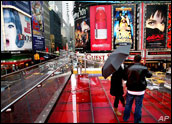
New York City has unveiled a new state-of-the-art information center designed to help both residents and tourists explore New York City through interactive maps and 3-D views of the city’s five boroughs. Designed with Google Maps, the interactive facility is focused on cultural events, museums, dining, entertainment and lodging.
“Our city’s travel and tourism industry is as important today as ever, and we’ve invested in new tools to attract visitors and formed innovative partnerships with brands such as Google and Travelocity to promote the city to people around the world,” noted New York City Mayor Michael Bloomberg.
“And by extending these new travel resources to our residents, we are giving New Yorkers the chance to more actively take advantage of the city’s diverse and exciting neighborhoods,” he added.
Making a guest post on the Official Google Blog, Bloomberg highlighted nycgo.com, a new site that uses Google Maps to help visitors plan their “New York experience and find hotels, restaurants and entertainment, in addition to exclusive citywide savings and promotions.”
Yeah, So Let’s Get to the Tech
While nycgo.com makes plenty of info available through a Web browser, new visitors to New York City might want to use the site to find the brand-new, brick-and-mortar Official New York City Information Center at 810 Seventh Avenue — between 52nd and 53rd Streets. The new information center is where the real action is.
Like a blast from the future, the Information Center’s large, interactive map tables “let you navigate venues and attractions as well as create personalized itineraries, which can be printed, e-mailed or sent to mobile devices. Additionally, there’s a gigantic video wall that utilizes Google Earth to display a 3-D model of New York City on which you can map out personalized itineraries,” Bloomberg noted.
The best way to experience the new Information Center from home is via a two-minute Google YouTube video embedded in the blog post. It shows users placing “pucks” on top of glowing interactive map tables, which let them choose an itinerary of things to do and places to go. Move the puck to another table, and you can follow the itinerary on a gigantic video wall via a Google Earth 3-D view of the city.
A Closer Look
So what’s NYC doing with those cool touchscreen map tables and wall-sized screen? They aren’t available at the local Best Buy store.
“NYC used our freely available Google Maps API (application programming interface) for Flash and worked with another partner, Local Projects, to implement it,” Elaine Filadelfo, a spokesperson for Google, told TechNewsWorld.
“The tools used by NYC are freely available online, and any city or tourist organization is welcome to use them,” she added.
So what’s running the interactive touchscreen tables? Microsoft Surface?
Nope. The nascent Surface isn’t programmed with Flash — these tables are custom jobs.
Enter Local Projects
Local Projects is a design studio that builds interactive design interfaces to tell stories and provide information in public spaces, museums, information centers, and the like. So what about the tables? And what’s up with the pucks?
“It’s basically a large-scale touch system with object recognition,” Jake Barton, principal and founder of Local Projects, told TechNewsWorld.
“It’s a two-camera system. One camera is doing touch recognition, the other is doing object recognition, and they come together as a series of sensor inputs to a Flash interface, which has the Google Maps API inside of it — but we had to do a lot of work to make the Google Maps API actually work the way that it’s working,” Barton explained.
“We wanted a special interface, and we had a lot of concerns about the color, the branding, the typography, the look and feel, the ways the puck interacts with the table, and we’re revealing a lot of information in custom ways. It took a lot of programming time and ingenuity to make Google Maps behave in a seamless way,” he added.
The development time took nine months. There are three tables, each about 8 by 4 feet. “They are the biggest I’ve ever seen,” Barton said.
Flying Itineraries
So how did the the idea of promoting New York businesses and cultural events turn into flying itineraries?
“We started with the idea of it being about smart brochures, where you have brochures on the walls and you pick them up and put them down and build an itinerary that way. It evolved into this sort of ‘you are here’ dot you place on interactive map tables,” Barton explained.
“And then we decided there was an opportunity to have visitors carry their customized guidebooks with them throughout the space,” he added. And key to that is making the itinerary portable in the Information Center, as well as outside of it.
“Visitors can publish itineraries to e-mail, send it to their phone, and they can print it or actually see the entire city through a Google Earth flyover that maps their custom route over the five boroughs,” Barton said.
“The key concepts were customization and portability,” he added.
Indeed — perhaps the new Information Center will become the first destination for new visitors.




















































